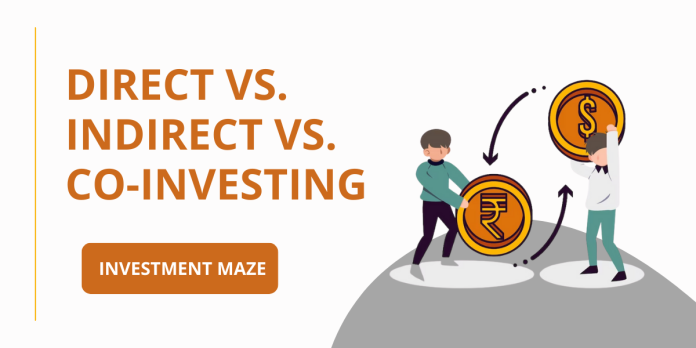Investing is like peeling an onion it may seem straightforward at first, but as you delve deeper, you uncover multiple layers of opportunities. When we embark on the journey of investing, we encounter various avenues, each offering distinct approaches be it direct, indirect, or co-investing.
As Warren Buffett wisely said, “Risk comes from not knowing what you’re doing.” Understanding these layers of investing is crucial for navigating the complex yet rewarding world of investments. Each approach offers a unique perspective, and the key is to choose the strategy that aligns with your goals, risk tolerance, and level of involvement.
Direct investing
It involves investing directly into an asset, such as a stock or a piece of real estate. This means that the investor has complete control over the investment and is responsible for managing it themselves. Direct investing can be a good way to get exposure to specific assets that the investor believes in, but it can also be risky, as the investor bears all of the responsibility for the investment’s success or failure.
Example: You decide to buy 100 shares of Company XYZ because you believe it will do well. You monitor the stock and decide when to sell.
Indirect investing
It involves investing through an intermediary, such as a mutual fund or a hedge fund. This means that the investor does not have direct control over the investments, but they can benefit from the expertise of the intermediary. Indirect investing can be a good way to diversify an investment portfolio and reduce risk, but it can also be less transparent than direct investing, as the investor does not have as much information about the underlying investments.
Example: You invest money in a Mutual Fund ABC. The fund manager buys shares of various companies using the pooled money from many investors.
Co-investing
It is a type of indirect investing where an investor invests alongside a fund. This means that the investor gets to share in the fund’s investment decisions and profits, but they also share in the fund’s risks. Co-investing can be a good way to get access to deals that would not be available to the investor individually, but it can also be more expensive than traditional indirect investing.
Example: You and a few friends decide to collectively invest in a start-up. Each person contributes money, and together you make decisions about the business.
| Feature | Direct Investing | Indirect Investing | Co-investing |
| Control | The investor has complete control over the investment | The investor has less control over the investment | Investor shares control of the investment with a fund |
| Risk | Investor bears all of the risk | Risk is shared with the intermediary | Risk is shared with the fund |
| Transparency | Investor has full transparency | Investor has less transparency | Investor has some transparency |
| Diversification | Can be difficult to diversify | Can be easy to diversify | Can be easy to diversify |
| Expertise | The investor is responsible for managing the investment | Investor benefits from the expertise of the intermediary | Investor benefits from the expertise of the fund |
| Cost | Can be expensive | Can be less expensive | Can be more expensive |
In general, direct investing is a good option for experienced investors who are comfortable with risk and want to have complete control over their investments. Indirect investing is a good option for investors who want to diversify their portfolios and reduce risk, but are not comfortable with managing their own investments. Co-investing is a good option for investors who want to get access to deals that would not be available to them individually but are willing to share control of the investment with a fund.
Also Know: Difference Between Trading and Investing
The best type of investment for an individual will depend on their circumstances, goals, and risk tolerance. Investors should carefully consider their options before making any investment decisions.


